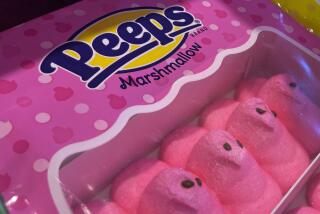Q&A: What are trans fats anyway, and why are they so bad?
What is a trans fat, and why is it so dangerous that the U.S. Food and Drug Administration wants it removed from the food supply?
These are just some of the questions on the minds of diners as they digest Thursday’s FDA action. Although consumption of artificial trans fats is already on the decline, FDA Commissioner Margaret A. Hamburg said further reductions could save 7,000 lives each year.
Need help understanding this news? Read on:
What is a trans fat?
These fats – also known as trans fatty acids – are made by adding hydrogen to liquid oil, which turns it into a solid, like margarine or Crisco. This makes it a handy ingredient for processed food manufacturers, since it improves the texture, stability and shelf life. It’s also inexpensive. Today, it’s often used in foods including microwave popcorn, coffee creamers, packaged cookies, cans of frosting and frozen pizza, among others.
Where does it come from?
Trans fats are a natural component of animal products such as milk and meat. The FDA says that it is synthesized in the guts of grazing animals.
Artificial trans fats were invented in 1901 by Wilhelm Normann. The German chemist added hydrogen gas to liquid oils and came up with a cheaper alternative to natural products like lard and butter. For many years, these partially hydrogenated oils were believed to be safer than trans fats from animals, according to the Center for Science in the Public Interest, or CSPI. But by the early 1990s, epidemiologists were realizing that the fats contributed to heart disease.
Why are trans fats bad for your health?
It’s not just bad, it’s doubly bad. For one thing, it increases blood levels of the “bad” cholesterol, low-density lipoprotein. High levels of LDL increase one’s risk of coronary heart disease, including angina, heart attacks and other potentially fatal problems, according to the Centers for Disease Control and Prevention.
To make matters worse, researchers also believe that trans fats reduce blood levels of high-density lipoprotein, the “good” cholesterol. HDL appears to reduce heart risks by funneling blood cholesterol to the liver, where it’s broken down and removed from the body. There’s also evidence that HDL slows the buildup of dangerous plaques in the arteries, the American Heart Assn. says.
CSPI, the nonprofit advocacy group that petitioned the FDA to require labeling of trans fats way back in 1994, has declared artificial trans fats “the most harmful fat of all” on a gram-per-gram basis.
Haven’t trans fats been banned already?
In some places, yes. In 2006, New York City became the first city to prohibit the use of artificial trans fats in restaurants and bakeries. California passed a law to phase out their use in restaurants in 2008. The first country to virtually ban artificial trans fats was Denmark, which took that action in 2003.
What about foods I buy in the grocery store?
Many food makers have reformulated their products to remove artificial trans fats – and when they do, they often tout their success on packages. Some examples of processed foods that are now trans-fat-free include Oreo cookies, Cheetos, Pop–tarts and instant Jell–O pudding.
So what exactly happened on Thursday?
The FDA announced its intent to remove partially hydrogenated oils from its list of ingredients that are “generally recognized as safe” (GRAS). That would effectively prevent food makers from using it in their products. Members of the public will have 60 days to comment on the proposal. If it takes effect, it would mark the first time since 1969 an item has been removed from the GRAS list. (Then, the artificial sweetener cyclamate was knocked off the list due to concerns about bladder cancer, liver damage and birth defects. Subsequent studies have found it to be safe in humans.)
Remind me again – what are partially hydrogenated oils?
These are the primary source of artificial trans fats. (Think of Wilhelm Normann adding hydrogen gas to liquid oils a century ago.)
Will this FDA action improve my health?
There’s good evidence that removing trans fats from foods – both through government regulation and voluntarily measure by industry – has already improved the nation’s health.
To cite just one example: Researchers from the CDC examined concentrations of trans fatty acids in blood samples collected as part of its ongoing National Health and Nutrition Examination Survey. They found that between 2000 and 2009, levels of four types of trans fatty acids fell by an average of 58%. They reported their results last year in the Journal of the American Medical Assn.
Another study based in part on the survey’s data calculated that the average American consumed 1.3 grams of artificial trans fats per day between 2003 and 2006. That’s a significant reduction from the 4.6 grams that the FDA said each American adult was eating every day (on average) in 2003. These findings were published in 2012 in the journal Food Additives and Contaminants.
If trans fats are so awful, shouldn’t I reduce my consumption to zero?
Not necessarily. It would be great to eliminate all artificial trans fats from your diet, but remember that some trans fats occur naturally in meat and dairy products. Unless you’re a vegan, you’ll probably keep eating some of the fats.
But you shouldn’t necessarily freak out about this. The Institute of Medicine considered this very question in a 2005 report and concluded that reducing trans fat consumption to zero would cause radical changes in diet that might deprive people of protein and essential micronutrients. The health consequences of this are “unknown and unquantifiable.”
If you’re interested in the latest health news, you like the things I write about. Follow me on Twitter and “like” Los Angeles Times Science & Health on Facebook.
ALSO:
Time to end the war against saturated fat?
Do you need to be a vegetarian to lead a healthy life?
FDA trans fat ban: Proposal makes clear no amount is safe







